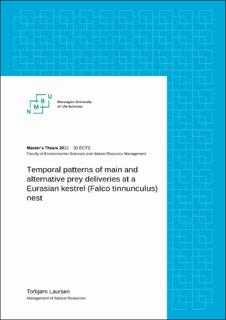| dc.description.abstract | Prey switching is an important part of predator feeding and breeding ecology since prey populations and therefore prey availability is dynamic. Deliveries of prey made by the Eurasian kestrel (Falco tinnunculus) breeding in a nest box in southern Norway, were recorded with a camera. Temporal activity of ground dwelling prey was recorded using five Reconyx cameras mounted in tunnel shaped boxes. Both were analysed in terms of temporal overlap. Total observations made of nest deliveries and camera traps, respectively were: 383 and 80 of Shrews (Sorex spp.), 190 and 6 of lemmings (Lemmus lemmus), 102 and 53 of the bank vole (Myodes glareolus), 60 and 64 Microtus voles (Microtus spp.) and 20 deliveries of birds to the nest. Shrews, Microtus voles and the bank vole were defined as the main prey and birds as an alternative prey. The main prey species had similar, but varying temporal patterns of activity and deliveries. The kestrel increased deliveries of birds (their alternative prey) when deliveries of main prey were decreasing in the hours between 11:00 and 18:00, the decrease in main prey deliveries around this time was small, and bird deliveries in these hours were probably an additive energy source. The kestrels deliveries of alternative prey did therefore follow a consistent hourly trend. Our results are similar with other findings made of Norwegian breeding kestrels by Steen et al., (2011a), where the same patterns of alternative prey deliveries occurred, around the same timeframe as our results, but with another alternative prey, the viviparous lizards (Zootoca vivipara). This consistent temporal change in prey composition, where alternative prey was commonly delivered for a brief period, should increase the prey mass delivered to the nestlings, and create a more stable feeding pattern throughout the day. The switch to an increase of bird being delivered at the nest were a discreet, but rapid form of prey switching. This thesis is to my knowledge the only study using this methodology to determine hourly changes in prey composition for a predator. | en_US |

